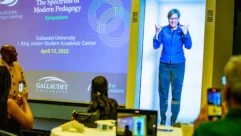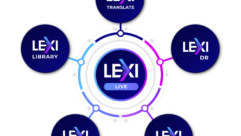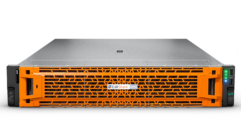
Sign Language
Jul 26, 2013 1:11 PM,
By Tim Kridel
Interactivity options for digital signage.

Walk into any bar, and it’s a safe bet you’ll find at least two things: digital signage and a mirrored wall of booze. The bar at Wolfgang Puck’s Trattoria del Lupo restaurant in Las Vegas is no exception, but it also bucks the stereotypes about what that signage can add to the experience.
Tucked inside the Mandalay Bay Resort and Casino, Trattoria del Lupo opened in 1999 and recently completed a major remodel that included adding interactive digital art to the bar in the middle of the restaurant. Four 42in. displays now adorn the top of the bar, but they’re not there to show ballgames or talking heads. Instead, they show streams and balls of light that, thanks to infrared cameras, ebb and flow based on bar patrons’ movements. For example, reaching for a drink can be enough to make the streams move in a way that mimics the breeze of an arm.
Interactive art is a rarity in bars and restaurants. So the artwork—titled “TRAILERS_LUPO”—was a test case not only for the Wolfgang Puck Fine Dining Group, which owns 14 other restaurants in cities such as Beverly Hills, Dallas, and London, but for the rest of the industry, too.
“It’s something they’re doing to change the way people look at digital signage and digital art,” says Curtis Kelly, who leads the systems design group at SenovvA, the Los Angeles-based integrator on the project. “I really applaud them for it. That’s been so successful that they’re now planning to do more restaurants. We’re getting ready to do another commission.”
BEHIND THE SCENES
In a way, the Trattoria del Lupo project got its start backstage at the Academy Awards, where SenovvA did the LED wall behind the stage. Digital artist John B. Carpenter was there, as well.
“The thing that really impressed me about their work at the awards was the seamless integration of the technology into the stage design and the way they were able to get a non-pixelated image for the audience by using a slight diffuser in front of the wall,” Carpenter says.
When Carpenter received the Trattoria del Lupo commission, he asked SenovvA to help execute his vision. One challenge was selecting the right hardware. Although many commercial AV installations now use consumer-grade monitors because they’re inexpensive, SenovvA and Carpenter agreed that approach would be shortsighted.
“It would be cheaper to do it that way, but you’re going to replace them four times [as often],” Carpenter says.
One reason is because “TRAILERS_LUPO” requires displays that are in portrait mode.
“You have to have a commercial display if you’re going to run it in portrait orientation because consumer displays don’t run properly in portrait,” Kelly says. “They’re designed to run and cool in landscape mode.”
SenovvA chose LG 42VS20-BAA LCDs. Kelly had used LG displays on other projects, but not this particular model. After comparing specs and talking with LG reps, this model stood out for several reasons:
- Its cooling adapts based on orientation, helping maximize its lifespan and avoiding downtime. A high-quality video card and power supply also help ensure reliability.
- It provides the high contrast ratio necessary to avoid washouts and blooming, as well as ample control of contrast and brightness. “With plasma, we probably could have got better black levels, but we wanted something that was going to be more robust on a commercial level running 24/7,” Kelly says. “Most digital signage displays are all about the nits. For us, it was more about contrast ratio and the black levels for a really natural look.”
- It includes a broad, deep menu, including options for scheduling and auto reboot, all accessible remotely from a Web browser.
- It offers an Ethernet port for remote access and monitoring, a feature that Kelly liked from other LG models. “I love them because they have a very good control protocol over IP or RS-232. Very robust. A very easy language to work with,” he says.
Networkability also was key for connecting each display to an Apple Mac Mini over HDMI. The infrared cameras—mounted underneath each display—connect to their respective Mini via USB.
Although they’re designed for the consumer market, Minis are increasingly common in pro AV. They were an ideal fit for Trattoria del Lupo partly because they have a solid-state drive (SSD), providing more reliability than a hard disk. SSDs also enable faster boot ups, which was a factor because the system is cycled off once a day. This clears the memory to ensure everything stays performing smoothly. After all, artwork that’s meant to mimic human movement and the wind can’t exist in fits and starts.
“It’s a very natural, smooth flow,” Kelly says. “So there had to be some specific things that had to be in the design development to make sure that the displays had a fast refresh rate so there wouldn’t be any jogginess. The computers had to have SSDs instead of [hard drives] because it’s running 24/7. They had to have fast refresh rates on the video cards.”
The infrared cameras also had to be flexible.
“The Kinetic cameras aren’t just standard ones you buy off the shelf,” Kelly says. “They’re professional models that can handle custom drivers.”
Sign Language
Jul 26, 2013 1:11 PM,
By Tim Kridel
Interactivity options for digital signage.
THINKING SMALL TO PUSH THE ENVELOPE
When the system was ready for installation, Carpenter didn’t simply hand SenovvA a thumb drive or DVD of code for them to load into the Minis. Instead, he was hands on, which isn’t surprising considering his background. Carpenter’s day job is as an engineer at Oblong Industries, a company whose founder inspired the gesture technology seen in the 2002 Tom Cruise movie Minority Report. Carpenter also has a private art practice, and in both, much of his time is spent programming.
“TRAILERS_LUPO” uses a program called Processing, a creative coding environment that Carpenter developed for artists and designers. The algorithms change the artwork based on environmental factors, so it never looks the same way twice. “It means you’re not dealing with a looped video,” Carpenter says. “You’re always getting something different.”
For Carpenter, the Mini is an ideal environment for realizing his visions. “One of the things we talked about is whether to use a simple video player or whether we needed a computer,” he says. “I like the Mac Mini because I’ve worked with them a lot, and they’re small and reliable.
“It’s the best solution for me right now. It’s a good space to write code in, and it behaves fairly predictably and reliably. I know a number of artists and creative coders that work with them just for the ease of installation.”
NEW LIFE FOR A DEAD SPACE
Trattoria del Lupo is an example of some of the ways that pro AV is changing. First, the use of Mac Minis instead of specialized AV hardware is part of the ongoing trend of AV-IT integration. Second, the project highlights the benefits of having the integrator work early, often, and well with a specialist from a different field. In some cases, that’s a building management engineer or an architect. Here, it was an artist. “Good open conversation, plus trusting that each group is good at what they’re doing” is what Carpenter believes is key for a great working relationship. “The expertise that they brought with the hardware and installation was fantastic. Working with SenovvA allowed me to focus on the code and artwork. I knew they were going to take care of the hardware and integration.”
“TRAILERS_LUPO” has been enough of a success that more interactivity is coming. The bar currently has four displays, but there’s room for another two if Trattoria del Lupo decides to expand the artwork. In the meantime, SenovvA and Carpenter have begun work on the area just behind the bar. Currently there are several French doors that lead to a small storage area. Those are being modified so that patrons see what appears to be a live street scene, with people walking by and trees moving in the wind. During the daytime, the scene will be lighter. The artwork is called “FIELDS_sinapis.”
“It’s a feeling of being somewhere else,” Kelly says.
In future interactive art projects, SenovvA will apply what it learned with “TRAILERS_LUPO.” For example, Carpenter currently accesses the system via a VPN, a design that SenovvA probably will avoid in the future.
“Since it’s more involved now with the systems, we’ll probably get involved with their IT department to plan on having a port opened just for us to keep it easy,” Kelly said. “They’re going to do more of these down the road, so maybe it’s time to start talking to them about integrating our allocation in their network for taking care of things. That’s becoming a trend. Everybody has to give people ports for the outside world to come in.”
That’s also yet another example of why AV integrators need IT skills these days and why they need to come into a project early on, when it’s cheaper and easier to make fundamental decisions about networks and other aspects.
“People call us to do a lot of black-box, weird things,” Kelly says. “We’re lucky enough to sit at the owner’s table at the stakeholder level to help them figure out if things can become reality and help them save money from the beginning. We value engineer it before it even gets to the RFP.”
Sign Language
Jul 26, 2013 1:11 PM,
By Tim Kridel
Interactivity options for digital signage.

Interactivity at Work: Northeastern University Visitor’s Center
At the Northeastern University Visitor’s Center, AV integration firm Whitlock installed four projectiondesign F32 SXGA+ DLP projectors in a 2×2 blended configuration driving one touchscreen measuring around 7.5ft. high by 9.25ft. wide. A pair of F32 1080p projectors mounted side-by-side powers a 2.5ft. by 9.25ft. banner area above. There is an almost identical configuration on the opposite wall that is only slightly wider to fit with the space available between the architectural glass wall and the lobby entrance. The ‘Spinning Globe’ screen uses two projectiondesign F32 SXGA+ resolution projectors throwing onto a surface 6.5ft. high by 5ft. wide, with a 4ft. banner area above powered by a single F32 1080p. PQ Labs Multi-Touch G32 overlays are used on the projection surfaces to bring motion data to a series of 12 network computers, allowing visitors to interact with its content using all 10 fingers. Visitors can pull up videos, still images, and information, choosing data on particular education programs using a GUI developed by Downstream. News feeds come from Twitter and RSS, while the static banners atop the two main walls display different content in keeping with the time of day and complementing the lobby’s LED lighting system.

Interactivity Options: Planar 4K Multi-touch Display
At InfoComm 2013, Planar Systems announced that it is adding multi-touch, multi-user capabilities to its Planar UltraRes Series 4K LCD display product line.
The addition of touch technology to the Planar UltraRes Series line of 4K displays expands Planar Systems’ ultra-high-definition category by combining a multi-touch experience with 4K-image clarity. It offers a solution for professionals who seek to collaborate or annotate using a large viewing area, the high image resolution, and enterprise-level features. It is also ideal for applications such as way finding, product catalogs, and any interactive digital signage designed to promote customer engagement.
The Planar UltraRes Touch offers six simultaneous touch points, so multiple users can collaborate and interact at the same time. The display recognizes common touch gestures including tapping, scrolling, pinching, and rotating. With a native 4K resolution of 3840×2160, Planar UltraRes Touch provides four times the resolution of a full HD display. The Planar UltraRes Touch is available in three versions: UltraRes Touch LX offers 350-nit brightness. It’s suitable for meeting rooms and control rooms for whiteboard, collaboration, videoconferencing, and presentation applications.
UltraRes Touch MX offers 500-nit brightness, and both landscape and portrait modes. It’s ideal for public venue and higher ambient light environments for branding, advertising, and interactive digital signage applications. UltraRes Touch 3D offers 420-nit brightness, and 2D and 3D viewing. It’s the ideal model for customers who work with 2D and 3D visual information for big data analysis, simulation, and a range of uses in the design industry.
Planar UltraRes Touch comes standard with fail-over power supplies; a quiet, fanless design; and a service access mode enabled by the Planar Profile mounting system. It has a logo-free metal bezel and a wide range of digital connectivity options. Using the Planar Profile mount, it installs less than 4in. from the wall, making it compliant with the Americans with Disabilities Act (ADA). Planar UltraRes Touch is available immediately.
Sign Language
Jul 26, 2013 1:11 PM,
By Tim Kridel
Interactivity options for digital signage.

Interactivity at Work: Engaging Art
The interactive exhibits in Cleveland Museum of Art’s Gallery One offer a new opportunity for patrons to appreciate art.
Visitors are engaging with displays and curating their own tours, thanks in part to Christie MicroTiles and Christie Interactivity Kit. Blending art and technology as part of a $100 million renovation, Gallery One’s “Collection Wall” is a 40ft.-wide multi-touch screen comprising two 15-units wide by five-units tall Christie MicroTiles videowalls using the Christie Interactivity Kit. Another four-unit wide by three-unit tall “Line and Shape” MicroTiles videowall also with an Interactivity Kit is located in Studio Play, Gallery One’s childhood learning zone.
Inspiring visitors and motivating the younger, tech-savvy demographic to explore the museum’s thousands of works, the Collection Wall allows up to 16 people to interact simultaneously with the wall using RFID tags on iPad stations. The resultsthey create also suggest further topics of interest. Visitors can personalize and build his or her collection, curating their own tour on the iPad using the museum’s ArtLens app.
The Line and Shape wall lets up to three children simultaneously draw lines or shapes. The content management software then finds and displays similar shaped artwork from the museum’s collection, encouraging participants to see shapes in everyday life.
Doug Fortney of Zenith Systems, project integrator, and his team also wrote software that generates a dead zone around the initial touch, preventing accidental touches such as a piece of loose clothing from creating an unintentional result. Powered by Baanto ShadowSense, the Christie Interactivity Kit adds multi-touch interactivity to any large-format, rectangular digital display. It lets multiple users interact simultaneously with a videowall with the resolution and speed needed to support finger-based gestures such as flicking, pinching, rotating, and scrolling. Scalable, and designed in pieces, Christie Interactivity Kit attaches to a videowall perimeter and is configurable into 84 different sizes with no drivers or manual calibration of sensors or cameras required.
“The technology is all about understanding how to look at art, appreciate art, and understand how different works of art have connections to each other, and this has become an iconic symbol of the gallery engaging visitors of all ages and backgrounds to interact with art in ways they have never before experienced,” says Christie’s Bob Christopher, central regional manager, Fixed Install. –Jessaca Gutierrez

New Interactive Options: Turnkey Videowall Solutions
This year at InfoComm, Christie introduced the new version of Christie Jumpstart content management system, the Christie FHD551-X with Corning Gorilla Glass, and the company’s first turnkey Multi-touch Video Wall Solution .
Christie Jumpstart now provides six outputs (compared with four previously offered) and a 50 percent increase in resolution capability, now 15 megapixels. Christie JumpStart features a 3.6GHz processor, 16GB memory, and 64-bit server for even faster performance and a more powerful workstation. Users can also send serial over IP commands to external devices by scheduling them at any point along the scenario timeline. Suitable Jumpstart markets include museums, universities, stadiums, corporate spaces, retail, and even rental.
The Christie FHD551-X 55in. super-narrow bezel LCD display for tiled videowalls with bonded Corning Gorilla Glass is ideal for touchscreens including broadcast sets and high-traffic public spaces including hotels, restaurants, museums, airports, and railway stations.
The turnkey Multi-touch Video Wall Solution comprises a four-unit-wide by one-unit-high row of portrait-mounted 55in. LCD panels with bonded Corning Gorilla Glass, Christie Interactivity Kit, Christie Jumpstart, and the mounting hardware for a wall-mounted or freestanding display. This allows customers to fulfill their entire videowall requirements with one vendor.
Christie Jumpstart, Christie FHD551-X with Corning Gorilla Glass, and Christie Multi-touch Video Wall Solution begin shipping this month.










